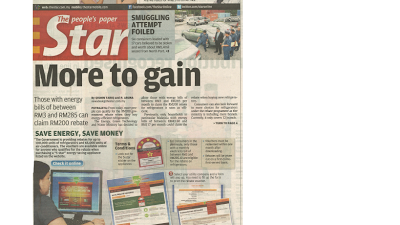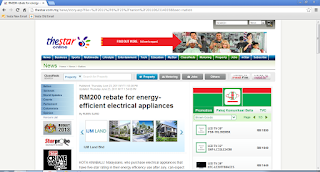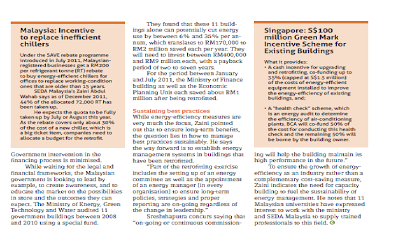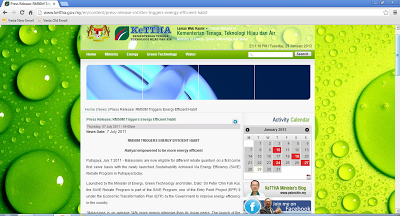OVERALL CAMPAIGN ANALYSIS BY THE PR CONSULTANT : MING KH AND ASSOCIATES
Awareness Campaign
The SAVE Program
Awareness Campaign
- Energy efficiency as a topic is still low priority among the media and the general public
- Chinese and English medium media are more supportive of the program with the BM papers not keen to carry the announcement during launch and updates of the SAVE Rebate Programme
- Online thread such at Lowyat.net shows that some people are interested in the program but new homeowners are questioning why they are not eligible especially since they will be buying new appliances
- Advertising campaign was interesting and piqued interest in the program but due to budget, the burst was too short
- Roadshows were effective in bringing the program to the grassroots and helped those who had trouble understanding the mechanics or had difficulty to print the voucher
- Roadshows are more successful outside of Klang Valley with more visitors in the evening and weekends
- Retailers’ training were helpful as an avenue for retailers to voice their grievances and clear doubts and misunderstandings
- SAVE Media Visits did not happen because energy efficiency is not a hot topic and editors were not interested
- Online presence should be continued as it is a viable channel to reach directly to the public and they are using it to clarify matters and seek for help when they encounter problem with the retailers
The SAVE Program
- Malaysians will love to save energy but prefer methods that will be easier and one that doesn’t change their current lifestyle
- Energy efficient appliances are still considered expensive even after the rebate
- Most find the mechanics to claim the rebate cumbersome even with proper guidelines given across all channels
- Some felt that the one-month period given to claim the rebate is too short and felt that they should be given a chance to re-print if they fail to claim it within the one-month period
- Online thread also highlighted concerns that retail shops participating in the program is more expensive than other shops even after the rebate is given
- Payment hiccup at the start of the program forced many retailers to doubt the program and that affected the redemption of vouchers when some of them refuse to do so until after they are paid
- Outstation retailers especially in the rural areas felt that the process was difficult
- Different implementation across Tenaga Nasional Bhd, SESCO and SESB means there is no one-rule-fit-all
- Example: Tenants are allowed to redeem the vouchers under TNB but they are not allowed to do so under SESCO (only owners are allowed)
- PR campaign should have switched to general topic of energy efficiency earlier after interest in the SAVE Program died down
- While general awareness was achieved, the advertising campaign should have had a stronger call to action during the initial launch
- From the first round of advertisements, people were aware that saving energy = saving money but weren’t aware that they could do so through the rebate vouchers
- With the limited budget, should have focused on a stronger campaign on radio to maximise budget instead of going for television
- There were however good feedback on the TV advertisement as it was eye catching and different from the usual Government-related advertisements
FINDINGS FROM A MARKET SURVEY BY AN EXTERNAL RESEARCH COMPANY
Survey Forms SAVE Rebate Program Effectiveness was sent to domestic consumers who have used vouchers SAVE Program in Jan-Mar 2012.
SURVEY METHOD
The survey was separated into different parts, each part with a focus on different aspects.
The last set of questions asked respondents to comment on whether the program should be continued and suggestions on how to improve.
Part 1: Awareness Campaign
This section emphasizes the level of awareness about the campaign entered. Options granted to enable the respondent to answer. The criteria include questions about
· Do you know about the SAVE program;
· How did you find out about this program, and
· Based on your knowledge, what are the goals of this program.
Part 2: Facilities in Getting the Vouchers
Information for access to vouchers used for the survey to the respondent for the purpose of maintenance of facilities provided by the program administrator to consumers SAVE Program. Questions cover
· From where did you get this rebate vouchers;
· Have you had trouble finding a link to print your voucher at the SAVE program website;
· Whether the information is too complicated to be filled, and
· Do you have difficulty printing vouchers.
Part 3:Facilities in Using the Vouchers
Identified three questions to find out the effectiveness of the use of vouchers and the redemption of the respondent. Among the questions posed are:
· Are the stores that participate in this program easily found and identified?;
· Are the documents should be carried along while using the voucher encrypt your purchase?; and
· Does the salesperson at the store allow you to create voucher redemption?.
Part 4: Effects of Energy Efficient Equipment
Questions for this part was to identify the impact on the use of vouchers and participation on the SAVE program of the respondent. Four (4) questions identified;
· By differentiating the previous electricity bill electricity bills when you use a refrigerator or air conditioner energy efficient, is there any change in the use of electricity at home?;
· Does the SAVE program to help you understand the concept of energy-efficient electrical appliances?;
· Does the SAVE program to help you understand the benefits of choosing energy efficient equipment through the Energy Efficiency label?; and
· Does this program make you more aware of energy conservation and efficiency practices at home?.
FINDINGS
The survey has revealed that 39% of those who responded on this program from the stores where they buy refrigerators and air conditioners, and this was followed by those who find through the newspaper (25%). Personal networks are also an important source of information, 15% of respondents said that they knew about the SAVE program through friends and relatives.
When asked about whether they know the reasons for the program, 37% said that it is to educate consumers about the importance of energy conservation and efficiency , while 32% said it was to provide rebates to homeowners, and the remaining 31% stating that it is to promote the use of energy-efficient products.
57% of respondents indicated that they have gotten their vouchers through the assistance of the dealers, while 39% of the SAVE website.
Although the majority did not have any major problems, a large minority (47%) have trouble finding a link to the voucher on the site, while 37% have difficulty understanding instructions and 47% had complications print them out.
For the convenience of using a voucher Moreover, 88% said that the stores that participate in this program easily found and identified. 80% of those surveyed revealed that their electricity consumption has gone down as a result of the SAVE program, while 93% indicated that it helped them understand the concept of energy efficiency.
Although there are still some issues that need to be associated with the SAVE program, such as making it easier for people to find and use the voucher, it can be categorized as a success.
This is reflected in how 97% of respondents said that this program should be continued. It is still early yet, and one would expect that by the time the next SEDA conducted studies, the results will be positive, if not better.
As at August 2011
As a whole, starting from the SAVE program launched until August 31, 2012, the estimated energy savings of 179.68 GWh and electricity bill savings of RM 39.17 million were achieved on the current number of units refrigerators and air conditioning, 5-star has sold either under the SAVE program or not .
The achievement of market share in the period July 7 to August 31, 2012 for refrigerators and air conditioners:
· 5-Star rated refrigerators: 242.3936 units (40.40%)
· 5-Star rated air conditioners: 159.102 units (26.52%)
· Total energy savings was 246.42 GWh. Carbon savings of 167.5 million tons
Through achieving the market share, the rate of reduction of carbon dioxide (CO2) emissions
· 5-Star rated refrigerators: 41,646.06 tonnes
· 5-Star rated air conditioners: 82,335.29
For Energy Efficient Chiller
Total capacity of market share for chillers with performance in compliance with MS1525:2007 Standard at 39.2% or 80,611 RT
SAVE Rebate Program had positive responses from all parties that include manufacturers, retailers, the owners of private companies and the public.
The overall everyone was able to understand and familiarize themselves with the mechanism to get rebate vouchers from the online system and the purchase and subsequent use rebate voucher redemption by the seller for every voucher that is used by the buyer.
Level of awareness and knowledge about the importance of using energy efficient equipment should also be improved among the crowd which aside from being able to buy energy-efficient equipment at a cheaper price, its use will also save the cost of electricity bills in the long run, particularly if there is any increase in electricity tariffs implemented by the government.
We must thank every one and every party who has involved and contributed to this success. It was a truly ONE MALAYSIA spirit to me throughout the whole process when everyone is giving their best shots, put aside all differences and committed to achieve goals that have been set in the program.
CONGRATULATION EVERYONE! IT WAS AN HONOUR TO KNOW AND WORKED WITH ALL OF YOU FOR BETTER MALAYSIA AND MALAYSIANS!
What’s next?
The rebate programs under SAVE Program has been a huge success but the main concern now is how to sustain that momentum.There is suppose to be a law on Minimum Energy Performance Standard(MEPS) and EE labeling by 2013 to ensure products with less energy efficient to be prohibited to enter the market which can be done through new regulations under Electricity Supply Act 1990.
This is where the clear policy on EE with specified targets is very crucial in the way forward as projected in ETP for Malaysia to become a developed country and high income economy by 2020.
However, as I mentioned in my previous posts...it has been a quiet year for EE lately and the ministry and agency which are responsible looking into does not look keen to carry this forward...we will see...and as always...this is not look urgent to them too
However, as I mentioned in my previous posts...it has been a quiet year for EE lately and the ministry and agency which are responsible looking into does not look keen to carry this forward...we will see...and as always...this is not look urgent to them too



.jpg)
.jpg)
.jpg)
.jpg)
.jpg)
.jpg)
.jpg)
.jpg)
.jpg)
.jpg)












































acson.png)










